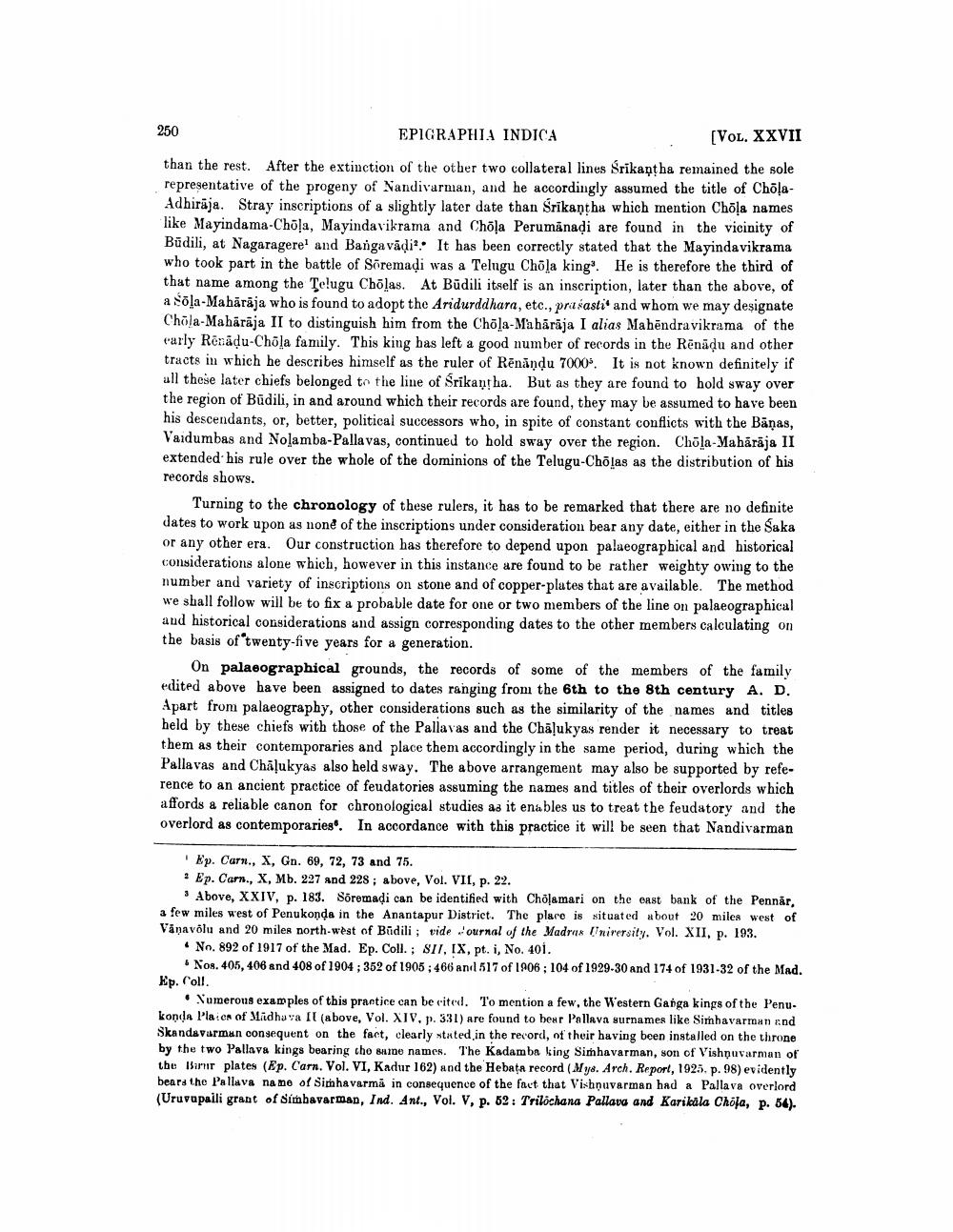________________
250
EPIGRAPHIA INDICA
(VOL. XXVII
than the rest. After the extinction of the other two collateral lines Srikantha remained the sole representative of the progeny of Nandivarman, and he accordingly assumed the title of ChõļaAdhiraja. Stray inscriptions of a slightly later date than Srikaộtha which mention Chõļa names like Mayindama-Chöļa, Mayindavikrama and Chõļa Perumanadi are found in the vicinity of Būdili, at Nagaragere' and Bangavādi?. It has been correctly stated that the Mayindavikrama who took part in the battle of Söremadi was a Telugu Chola king. He is therefore the third of that name among the Telugu Cholas. At Budili itself is an inscription, later than the above, of a Sola-Mahārāja who is found to adopt the Aridurddhara, etc., prasasti' and whom we may designate Chöla-Mahārāja II to distinguish him from the Chola Maharaja I alias Mahendravikrama of the carly Ronādu-Chõla family. This king has left a good number of records in the Rēnādu and other tracts in which he describes himself as the ruler of Rēnāndu 7000. It is not known definitely if all these later chiefs belonged to the line of Srikantha. But as they are found to hold sway over the region of Būdili, in and around which their records are found, they may be assumed to have been his descendants, or, better, political successors who, in spite of constant conflicts with the Banas, Vaidumbas and Nolamba-Pallavas, continued to hold sway over the region. Chola-Mahārāja II extended his rule over the whole of the dominions of the Telugu-Cholas as the distribution of his records shows.
Turning to the chronology of these rulers, it has to be remarked that there are no definite dates to work upon as none of the inscriptions under consideration bear any date, either in the Saka or any other era. Our construction has therefore to depend upon palaeographical and historical considerations alone which, however in this instance are found to be rather weighty owing to the number and variety of inscriptions on stone and of copper-plates that are available. The method we shall follow will be to fix a probable date for one or two members of the line on palaeographical and historical considerations and assign corresponding dates to the other members calculating on the basis of twenty-five years for a generation.
On palaeographical grounds, the records of some of the members of the family edited above have been assigned to dates ranging from the 6th to the 8th century A. D. Apart from palaeography, other considerations such as the similarity of the names and titles held by these chiefs with those of the Pallavas and the Chāļukyas render it necessary to treat them as their contemporaries and place them accordingly in the same period, during which the Pallavas and Chalukyas also held sway. The above arrangement may also be supported by reference to an ancient practice of feudatories assuming the names and titles of their overlords which affords a reliable canon for chronological studies as it enables us to treat the feudatory and the overlord as contemporaries. In accordance with this practice it will be seen that Nandivarman
Ep. Carn., X, Gn. 69, 72, 73 and 75. ? Ep. Carn., X, Mb. 227 and 228 ; above, Vol. VII, p. 22.
Above, XXIV, p. 183. Söremadi can be identified with Choļamari on the east bank of the Pennar, a few miles west of Penukonda in the Anantapur District. The place is situated about 20 miles west of Väņavõlu and 20 miles north-west of Būdili; vide ournal of the Madrax Unirersity. Vol. XII, p. 193.
• No. 892 of 1917 of the Mad. Ep. Coll. ; SIT, IX, pt. i, No. 401.
. Nos. 405,406 and 408 of 1904 ; 352 of 1905 : 466 and 517 of 1906 : 104 of 1929-30 and 174 of 1931-32 of the Mad. Ep. Coll.
• Numerous examples of this practice can be cited. To mention a few, the Western Ganga kings of the Penukonda Pla es of Midhasa Il (above, Vol. XIV. p. 331) are found to bear Pallava surnames like Simhavarman and Skandavarman consequent on the fact, clearly stated in the record, of their having been installed on the throne by the two Pallava kings bearing the shine names. The Kadamba king Simhavarman, son of Vishnuvarman of the Iarnir plates (Ep. Carn. Vol. VI, Kadur 162) and the Hebata record (Mys. Arch. Report, 1925, p. 98) evidently bears the Pallava namo of Simhavarma in consequence of the fact that Vishnuvarman had a Pallava overlord (Uruvapaili grant of Simbavarman, Ind. Ant., Vol. V, p. 52: Trilochana Pallava and Karikala Choja, p. 54).




